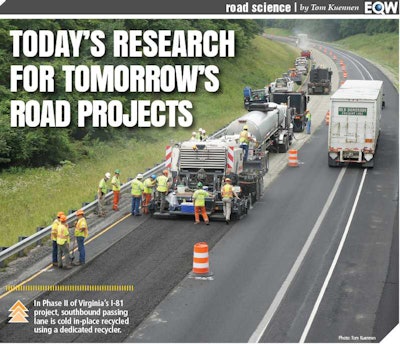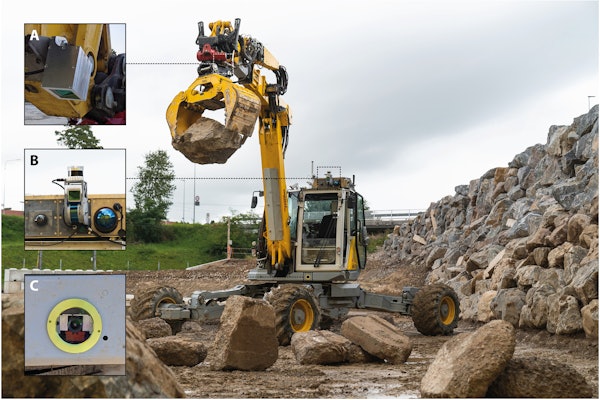
Four of these papers – involving full-depth reclamation (FDR) for a major interstate pavement, roller-compacted concrete, portland cement/limestone blends, and glow-in-the-dark concrete – may impact how contractors build future highway pavements. Here’s an overview:
Virginia’s I-81
North America’s first highway reconstruction combining cold in-place recycling, cold central-plant recycling, and full-depth reclamation all in one project is now performing “excellently,” according to a 2015 TRB paper.1 The Virginia Department of Transportation rebuilt the section of I-81 in the shadow of the Blue Ridge Mountains in 2011.
In Phase I, VDOT rehabilitated a 3.7-mile section of I-81 southbound near Staunton using cold in-place recycling, cold central-plant recycling and full-depth reclamation. The high-profile project used cold milling machines, a reclaimer, a portable cold-mix plant and a cold recycler, in addition to rollers and asphalt pavers.
The processes were performed both “in place” within the roadbed and adjacent to the highway, and contractors reused existing material from the underlying road structure. The driving surface received a new overlay of hot-mix asphalt.
After rebuilding the shoulders to accommodate work zone traffic, the top 10 inches of asphalt from the right-hand lane were removed using two large cold mills, and brought to a mobile cold recycling plant near the interstate, adjacent to the work zone. There the materials were stabilized with a combination of foamed asphalt and portland cement using cold central-plant recycling (CPR).
Meanwhile, a subcontractor stabilized the revealed, existing aggregate subbase – which had deteriorated to the point of causing damage to the overlying bound layers – with 3 percent lime kiln dust, a reclaimed industrial byproduct, to a depth of 12 inches using a reclaimer. The stabilized materials were compacted in-place with padfoot and smooth drum rollers.
The milled, recycled materials from the mobile cold-recycling plant then were used to pave a new base course over the stabilized aggregate subbase to a 6-inch compacted depth. This later was topped with a 4-inch intermediate course of conventional hot-mix asphalt and a 2-inch surface course of stone-matrix asphalt.
In Phase II of the project, a larger cold recycler performed cold in-place recycling (CIR) in the left-hand passing lane. For this work, the top 2 inches of the pavement was milled and the next 5 inches was recycled in situ using foamed asphalt and portland cement as the stabilizing agents. It then was topped with a 2-inch hot-mix asphalt intermediate course and a 2-inch surface course of stone-matrix asphalt.
“The section of pavement rehabilitated by the three in-place recycling methods continues to perform well after nearly three years of heavy interstate traffic,” report the authors. “To date, approximately 6 million equivalent single axle loads have been applied. The initial performance of the I-81 pavement section rehabilitated with in-place recycling techniques can be considered excellent.”
1 Initial Performance of Virginia’s Interstate 81 In-Place Pavement Recycling Project, by Brian K. Diefenderfer, Ph.D., P.E., Benjamin F. Bowers, Ph.D., Virginia Center for Transportation Innovation and Research, Charlottesville, and Alex K. Apeagyei, Ph.D., P.E., University of Nottingham, England.
Roller-compacted concrete with asphalt overlay
Roller-compacted concrete (RCC) is accepted for mass placements of concrete, such as truck depot parking areas and dams, but its inherent roughness has made it seldom-used for highway pavements. The Virginia DOT, however, has placed its first RCC pavement and is evaluating it for performance, according to a 2015 TRB paper.2
RCC is a relatively stiff mixture of aggregate, cementitious materials and water that is placed using asphalt pavers instead of slipform pavers, is compacted by vibratory rollers and hardens into concrete. It contains a low amount of water, exhibits no slump, and can be placed and opened to traffic in a short period of time.
“[RCC] does not contain reinforcement, tie-bars or dowels,” Hossain and Ozyildirim say. “All of these factors combine to produce a relatively low-cost roadway compared to either asphalt or conventional concrete pavements. However, such a roadway may lack the smoothness required for high-speed roadways and can experience raveling and/or cracking.”
While an asphalt overlay could remedy the smoothness and raveling issues, cracks might reflect through the asphalt layer, they caution. However, using a composite pavement of RCC and asphalt overlay might be a cost-effective, long-lasting pavement system.
In this test, VDOT rebuilt roadways leading to the Staffordboro “Park and Ride” commuter lot. Roller compacted concrete was used to rehabilitate Staffordboro Blvd. (S.R. 684) near the Garrisonville Road (S.R. 610)/ I-95 interchange and other connector roadways leading to and within the parking lot.
RCC could be constructed at reasonable cost using only night time or weekend construction, and the pavement was designed to withstand a high volume of heavily loaded trucks and buses, they say. Contractors paved Staffordboro Blvd. with 8 inches of RCC and used 6 inches of RCC on the rest of the access roads inside the parking lot. In order to achieve a smoother riding surface, all RCC was overlaid with 2 inches of asphalt surface course.
The authors concluded that the RCC project was successful, and that RCC with strengths exceeding 1,600 psi at 12 hours, 2,500 psi in 24 hours and 4,000 psi at 28 days can be achieved.
2 VDOT’s First Roller-Compacted Concrete Pavement, by M. Shabbir Hossain, Ph.D., P.E., and Celik Ozyildirim, Ph.D., P.E., Virginia Center for Transportation Innovation & Research, Virginia Center for Transportation Innovation & Research, Charlottesville
Louisiana limestone/cement blends
Interground limestone/cement blends are appropriate for all uses in the Pelican State, according to a new TRB paper.3
Portland cement concrete (PCC) is the world’s most versatile and most used construction material, Rupnow and Icenogle say, but it occupies a substantial carbon emissions “footprint.” But a new method of reducing the carbon footprint of PCC incorporates a much larger portion of interground limestone (Type IL cement) into the cement.
Standards organization ASTM and the American Association of State Highway and Transportation Officials have now changed specification language of ASTM C595 and AASHTO M240 to allow up to 15 percent use of interground limestone, the authors report. The incorporation of the increased limestone content significantly reduces the carbon dioxide footprint of the resultant PCC while extending the life of cement quarries. Use of the blend also permits cement manufacturers to make its cement “go farther,” producing more cementitious material without having to expand production facilities, thus sidestepping associated capital expenditures and environmental permitting.
To evaluate the new Type IL cement, the researchers characterized the fresh and hardened concrete properties of binary (two-cementitious component including portland cement) and ternary (three-component) combinations incorporating Type IL cement.
“The results of this study showed that the use of Type IL portland cement in Louisiana should be allowed for all applications, including ternary mixtures up to 70 percent replacement,” Rupnow and Icenogle report. “Compressive and flexural strength results were comparable. Type IL mixtures exhibited less shrinkage when compared to the control mixtures with Type I cement. Surface resistivity results were comparable and indicated that the surface resistivity meter use will be applicable for mixtures containing Type IL cement.”
3 Louisiana’s Laboratory Experience with Type IL Portland Cement, by Tyson D. Rupnow, Ph.D, P.E., and Patrick J. Icenogle, P.E., Louisiana Transportation Research Center, Baton Rouge.
Nearly half recycled concrete in PCC pavements
Replacing up to 45 percent by volume of natural course aggregate with recycled concrete aggregate (RCA) had no significant effects on any of the concrete properties studied, says TRB research.4 This indicates high-quality RCA can be used as a replacement for a portion of the coarse natural aggregates in new portland cement concrete pavements.
Variables in the study included the source of the RCA, percent replacement of coarse natural aggregate with RCA (0 to 45 percent), and percent replacement of portland cement with Class F fly ash (0 or 20 percent). RCA from all three sources met the Washington State DOT requirements for aggregates, and all fresh and hardened concrete properties met WSDOT requirements as well, they say.
“The effects of RCA on fresh concrete properties were evaluated by measuring slump, air content, and density,” the authors write. “Slump and air content were controlled parameters in the batching process, with targets specified by WSDOT of 1 to 3 inches for slump and 3 to 7 percent for air content.”
The effects of RCA on hardened concrete properties were evaluated by measuring compressive strength, modulus of rupture, coefficient of thermal expansion, drying shrinkage and freeze-thaw durability.
“Test results showed that up to a 45 percent replacement of coarse natural aggregate with RCA had no significant effect on any of the hardened concrete properties tested,” Wen, McLean and Willoughby conclude. “In addition, all samples tested met WSDOT minimum strength requirements for use in concrete pavements.” The authors emphasize that these results were obtained using RCA obtained from demolished pavements incorporating high-quality original materials.
4 Evaluation of Recycled Concrete as Aggregates in New Concrete Pavements, by Haifang Wen, Ph.D., P.E., Washington State University, David I. McLean, Ph.D., P.E., Colorado State University, and Kim Willoughby, Washington State DOT.
Light-emitting concrete
Concrete pavements can emit light, with important safety benefits, according to a provocative new TRB paper.5
The researchers developed a soy-based luminescent “glow in the dark” (GITD) sealant for use on concrete surfaces. The luminescent sealant is a mixture of soy methyl ester polystyrene (SME-PS) and strontium aluminate; a phosphorescent powder that slowly luminesces after being excited by light.
The sealant that could be applied to the surface of concrete has important safety benefits, in addition to creating a more durable pavement, the authors say. “GITD concrete sealant could be used to seal concrete for increased service life, to supplement streetlights, and to increase the safety of the traveling public at night,” they say. “If successful, the GITD sealant could be used to improve safety in construction zones or possibly replace streetlights in certain applications.”
As GITD powder derives its luminescent qualities from sunlight, it’s more efficient than streetlights, which send light in all directions and draw approximately 2.3 percent of global electricity consumption.
Safety of roadways would be increased by using a glow in the dark sealant as drivers will be able to see the road, its edges, or critical features more clearly, the authors write. “Roads, pedestrian trails, construction barrier walls, bridge piers, provide just some of the other potential applications for a GITD sealant,” they say. “Using a luminescent concrete sealant, one achieves a reduction of energy consumption by reducing or replacing streetlights, placing light where it is needed, sealing the concrete for a more durable pavement, and increased safety for the public.”
5 Assessing the Performance of Glow in the Dark Concrete, by Andrew Wiese, Taylor Washington, Dr. Bernard Tao and Dr. Jason Weiss, Purdue University.












